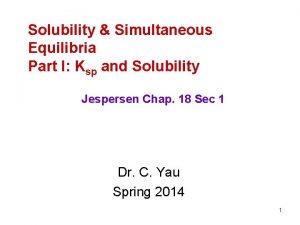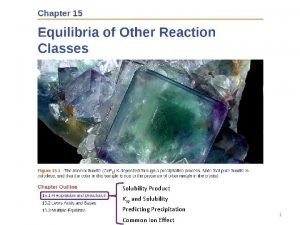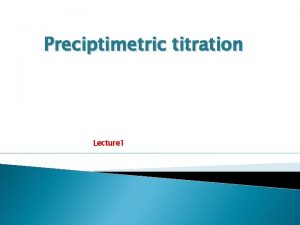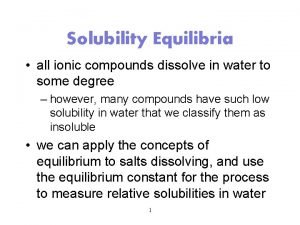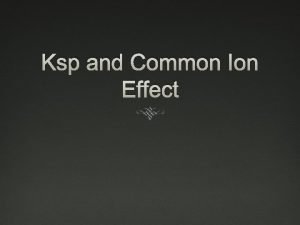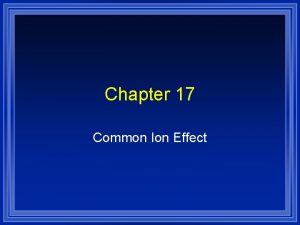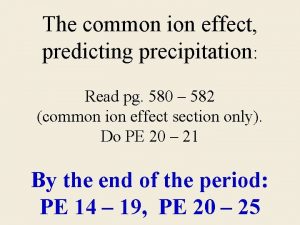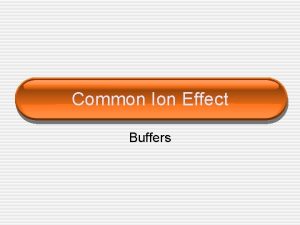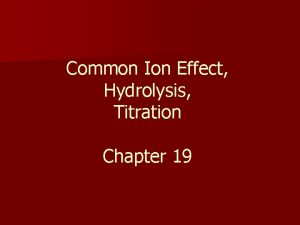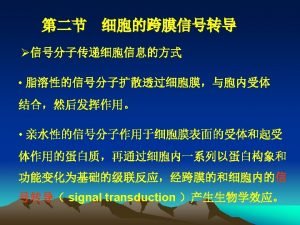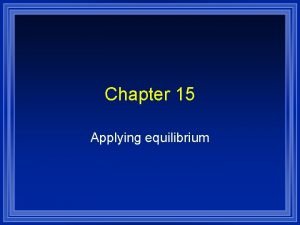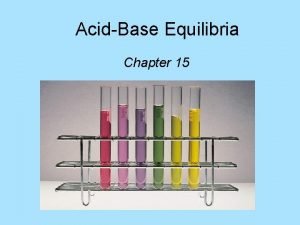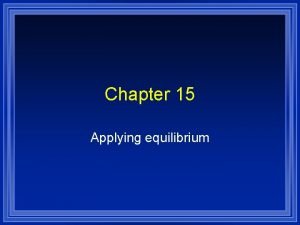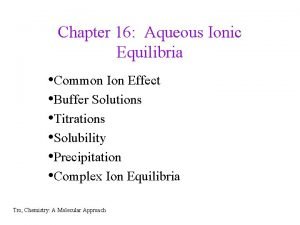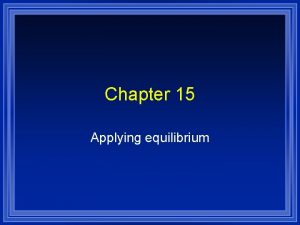Chapter 17 Common Ion Effect Drill l Use
















![STEP 4: Determine and solve the equilibrium constant expression: l Ka = ([H+][C 2 STEP 4: Determine and solve the equilibrium constant expression: l Ka = ([H+][C 2](https://slidetodoc.com/presentation_image_h2/3f4a058d3aac8eccba1c87cac5f11441/image-17.jpg)



- Slides: 20

Chapter 17 Common Ion Effect

Drill l Use AP Review Drill # 50 -53

Objectives SWBAT l Complete Common Ion Effect calculations. l Explain how the Common Ion Effect is a special case of Le Chatelier’s Principle. l

Common Ion Effect l The Common Ion Effect is the shift in equilibrium caused by the addition of a compound having an ion in common with the dissolved substance.

Uses of Common Ion Effect l The common ion effect plays an important role in determining: l the p. H of a solution l and the solubility of a slightly soluble salt. l

The Common Ion Effect When a salt, with the anion of a weak acid, is added to that acid the addition of the salt reverses the dissociation of the acid. l Acid Dissociation: l CH 3 COOH CH 3 COO -1 + H+1 l Salt that is added: l Na. CH 3 COO -1 + Na+1 l

Common Ion Effect l Addition of the salt will increase the concentration of the CH 3 COO-1 ion. l Le Chatelier’s Principle says that the increased ion concentration will reverse the equilibrium reaction. This reversal decreases production of the products and increases production of the reactants.

Equilibrium Special Case l You have probably realized that the Common Ion Effect is just a special case of Le Chatelier’s Principle.

Common Ion Effect Lowers the percent dissociation of the acid. (If the equilibrium shifts left, you produce less products. ) l The same principle applies to salts with the cation of a weak base. l This is an “ICE BOX” problem with an exception. Now you have an initial concentration of the anion. l

Common Ion Effect Example l In this situation, the soluble salt of the weak acid's conjugate base simply provides a source of the conjugate base.

Consider acetic acid in water: l HC 2 H 3 O 2 (aq) ↔ H+ (aq) + C 2 H 3 O 2 - (aq) l Now, add Na. C 2 H 3 O 2, which dissociates completely, we increase the concentration of C 2 H 3 O 2 -1 (aq). l l l Le Chatelier's Principle : the equilibrium will shift to the left (towards the reactants), causing the [H+] to decrease, and therefore the p. H increases!

Common Ion Effect l The common ion effect is the shift in equilibrium that occurs when an ion ALREADY PRESENT in the equilibrium reaction is added.

EXAMPLE l If 0. 100 moles of Na. C 2 H 3 O 2 are added to a 1. 00 L of 0. 100 M solution of acetic acid, HC 2 H 3 O 2, what is the resultant p. H ?

STEP 1: Identify the major species in solution l HC 2 H 3 O 2 (weak acid) l Na+1 (neither acidic nor basic which means it is a SPECTATOR ION) l C 2 H 3 O 2 -1 (conjugate base of weak acid) l H 2 O (very weak acid or base, amphoteric)

STEP 2: Identify the important equilibrium reaction(s). In this case it is a reaction that involves both the weak acid and its conjugate base: HC 2 H 3 O 2 (aq) ↔ H+ (aq) + C 2 H 3 O 2 -1 (aq)

STEP 3: Make an I. C. E. table to determine the equilibrium concentrations of substances: HC 2 H 3 O 2 (aq) ↔ H+ (aq) + C 2 H 3 O 2 -1 (aq) http: //www. chem. ubc. ca/courseware/p. H/section 12/index. html
![STEP 4 Determine and solve the equilibrium constant expression l Ka HC 2 STEP 4: Determine and solve the equilibrium constant expression: l Ka = ([H+][C 2](https://slidetodoc.com/presentation_image_h2/3f4a058d3aac8eccba1c87cac5f11441/image-17.jpg)
STEP 4: Determine and solve the equilibrium constant expression: l Ka = ([H+][C 2 H 3 O 2 -1] / [HC 2 H 3 O 2] ) l 1. 8 x 10 -5 = ( x(0. 100 + x) / (0. 100 - x) ) l Use the 5% assumption. l 1. 8 x 10 -5 = ( x(0. 100) / (0. 100) ) x = [H+] = 1. 8 x 10 -5 l

STEP 5: Calculate the p. H! l p. H = -log(1. 8 x 10 -5) = 4. 74 l The addition of a common ion can also affect the dissociation of a weak base in a similar manner. l See http: //www. chem. ubc. ca/courseware/p. H/secti on 12/index. html for more information.

Practice Problems l Try B&L #

Wrap Up l How is the Common Ion Effect a special case of Le Chatelier’s Principle?
 Common ion effect example
Common ion effect example Saturated
Saturated Solubility vs solubility product
Solubility vs solubility product Common ion effect explained
Common ion effect explained Applications of common ion effect
Applications of common ion effect Common ion effect example
Common ion effect example Common ion effect example
Common ion effect example Common ion effect example
Common ion effect example Common ion solubility
Common ion solubility Solubility vs solubility product
Solubility vs solubility product Ksp common ion effect
Ksp common ion effect Write note on common ion effect
Write note on common ion effect Common ion effect practice problems
Common ion effect practice problems Common ion effect
Common ion effect Molar solubility
Molar solubility Ejemplo de fuerza ion ion
Ejemplo de fuerza ion ion Ion dipolo
Ion dipolo Uniones intramoleculares
Uniones intramoleculares Dispersion forces examples
Dispersion forces examples What is reaming a hole
What is reaming a hole Pillar drill use
Pillar drill use

